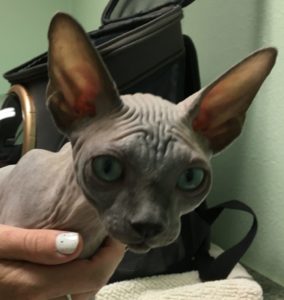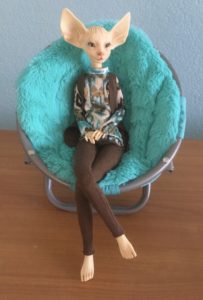
Did you know that about 1 in 3 people in the United States are allergic to cats and dogs? Those of us who are mildly “allergic” are familiar with the sneezing and runny nose that may come with handling our pets. More severe reactions may include signs of asthma, such as wheezing and difficulty breathing.
What makes us allergic to cats?
A protein called Fel d1 is the primary allergen in cats, accounting for about 95% of the allergy responses in adults sensitive to cats. Fel d1 is mainly produced in the cat’s salivary and sebaceous glands and is spread through the cat’s fur as he grooms. As he sheds fur and skin (dander), Fel d1 is distributed throughout your home. Breathing in dander or having contact with it can trigger an allergic reaction in a sensitive person.
Fel d1 is light, easily airborne and can be found just about everywhere, even in pet-free homes and institutions such as schools. Usually these levels are low and do not impact people in general.
Reducing Fel d1 in your home
Being allergic to cats does not always mean you have to re-home your feline friend. What you need to do is reduce the amount of Fel d1 in your home. Here are some things you can do:
- Fur tends to “stick” more to fabrics – vacuum upholstery and carpets frequently.
- Consider switching out carpet for hardwood or vinyl floors.
- Use covers that you can launder on sofas and upholstered chairs.
- HEPA air filters and HEPA vacuum filters can also help.
- Clean regularly and frequently.
- Open the windows when you can.
What about bathing my cat?
Bathing your cat does reduce the amount of Fel d1. Researchers do not agree on how long the beneficial effects last – one study found that washing cats significantly reduced the airborne amount of allergen but the levels of Fel d1 returned to pre-wash levels within the week. Many cats do not like to be bathed – a weekly bath may become a weekly battle.
Purina has developed a waterless shampoo for reducing Fel d1 which does not require immersing the cat in a tub or hosing her down. This may be easier to use if you want to try bathing your cat. The shampoo is said to reduce allergens 33% in 24 hours .
Chickens and Eggs – can they keep us from being allergic to cats?
Chickens produce antibodies against environmental antigens that they can transfer into their eggs and give their chicks immunity against these antigens. Researchers at Nestle-Purina were able to develop an “anti-Fel d1” antibody by exposing hens to Fel d1. This “ anti-Fel d1” reduces the amount of active Fel d1 in the cat’s saliva when the cat eats food containing the “anti- Fel d1” egg product. Purina “Live Clear” is now commercially available after 10 years of research and studies. It has been shown to reduce active Fel d1 by an average of 47% after 3 weeks of feeding.
“Hypoallergenic” cats
All cats produce Fel d1 – some produce more than others. Intact male cats produce more Fel d1 than female cats and neutered and spayed cats. Older cats may produce less Fel d1 than younger ones.
Some cat breeds are known for not producing much Fel d1. These cats typically do not shed much. It is thought that the reduction in the amount of hair reduces the amount of Fel d1 in the environment. On the other hand, these cats still groom and spread dander that has sebaceous secretions containing Fel d1. Among breeds thought to produce less Fel d1 are:
- Sphynx
- Cornish and Devon Rex
- Siberian cats (may have a genetic mutation that causes them to release less Fel d1)
- Russian blue
- Balinese
- Peterbald

What does the future hold for those of us who are allergic to cats?
The Crisper Cat: A Virginia based company, Indoor Biotechnologies, is looking into removing the Fel d1 gene from cat cells in order to develop a truly “hypoallergenic” cat.
A Vaccine to Make Cats less Allergenic: Saiba Animal Health is developing a vaccine for cats that will induce “anti-Fel d1” antibodies to form in vaccinated cats. These antibodies will bind Fel d1 and will effectively neutralize its allergenic effect on humans.



Chris Meyer says:
Fantastic! This may really help some people and their cats. Is the doll Cal’s work?